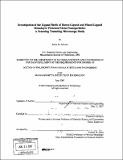Investigation of the ligand shells of homo-ligand and mixed-ligand monolayer protected metal nanoparticles : a scanning tunneling microscopy study
Author(s)
Jackson, Alicia M
DownloadFull printable version (15.85Mb)
Other Contributors
Massachusetts Institute of Technology. Dept. of Materials Science and Engineering.
Advisor
Francesco Stellacci.
Terms of use
Metadata
Show full item recordAbstract
Monolayer Protected Metal Nanoparticles have recently found widespread use in and are the focus of intensive study in many areas of scientific research ranging from biology to physics to medicine. Consisting of a nanoscale, crystalline, metallic core surrounded by a self-assembled monolayer of ligands (a 3-D SAM or ligand shell), their appeal and utility stem from their numerous unique properties-many of which arise and are modulated by the intimate spatial and electronic contact between core and shell. The ligand shell controls the particle's interactions with its environment (e.g. sensing, assembly, and electron transfer ability). Furthermore, the ability to manipulate and assemble such nanomaterials through the ligand shell is paramount to their incorporation into and the development of new nanoparticle based materials and devices. However, little is known of the exact composition and packing arrangements of molecules within the ligand shell, and even less so on how to control the resulting nanostructuring. In this thesis we present a Scanning Tunneling Microscopy investigation of the ligand shells of homo- and mixed-ligand metal nanoparticles. (cont.) We develop an understanding and model of the ligand arrangements around the nanoparticle core, showing that the multifaceted, high curvature, and topologically spherical nature of the core results in a 3-D SAM that has many differences from its 2-D SAM counterparts. We show that the core curvature (and correspondingly, the changing facet to edge ratio on the core surface) of the particles is the dominant driver for the packing and behavior of the ligand shell. Most interestingly, we find that when certain two-component, mixed SAMs are assembled around the particle core, the ligands phase-separate into ordered, ribbon-like domains, only a few molecules in width-a behavior never before seen on flat surfaces. We show that both the domain morphology and width can be controlled through the ligand shell composition and the particle core size, and that the observed phase-separation is a general phenomenon across nanoparticle compositions. We present these studies as a first step towards developing a complete model of and control over the ligand shell structure of nanoparticles.
Description
Thesis (Ph. D.)--Massachusetts Institute of Technology, Dept. of Materials Science and Engineering, 2007. Includes bibliographical references.
Date issued
2007Department
Massachusetts Institute of Technology. Department of Materials Science and EngineeringPublisher
Massachusetts Institute of Technology
Keywords
Materials Science and Engineering.